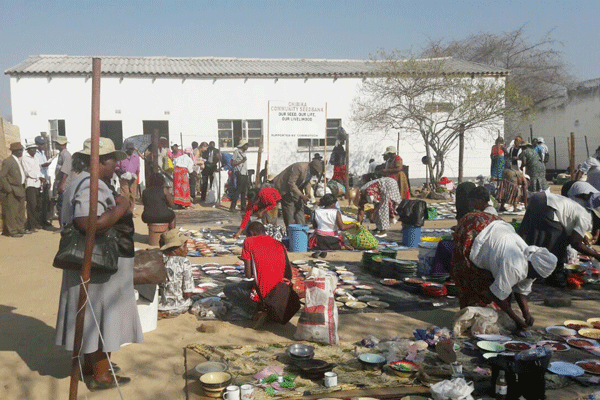
Munacho Nyamayedenga (61) says he has never been formally employed but still managed to look after his family through subsistence farming in the rocky and arid region of Uzumba-Maramba-Pfungwe (UMP).
by Everson Mushava

Nyamayedenga says he has managed to see all his six children through school from agriculture, but laments that last year’s El Niño-induced drought and “soil tiredness” brought new challenges that have left most people in the community in need of food aid.
With the country faced with a La Nina phenomenon in the 2017 agricultural season, which is expected to bring floods to most parts of the country, the country’s food situation is likely to be dire again.
But Nyamayedenga is hopeful that if the communities resort to traditional crop varieties such as small grains, the country’s food situation could improve.
“As you can see, this is dry land but we have managed to sustain our families through farming of small grains and crops that are resistant to drought,” Nyamayedenga told The Standard on the side-lines of a seed exhibition at Chibika Community Seed Bank in the district on Thursday.
The seed expo has been used for many years in UMP as a way of conserving the various local crop breeds and varieties that have been critical for the survival of the country’s indigenous food crop resources.
The seed and food fair award ceremony is also aimed at encouraging communal farmers to develop a greater understanding of crop variety in the face of climate change.
- Chamisa under fire over US$120K donation
- Mavhunga puts DeMbare into Chibuku quarterfinals
- Pension funds bet on Cabora Bassa oilfields
- Councils defy govt fire tender directive
Keep Reading
“Last year we had very low rains and our harvests were very poor. At the moment, we are surviving on food hand-outs from government and non-governmental organisations,” Nyamayedenga said.
Nyamayedenga could not hide his frustration while recounting the various challenges the people in drought-prone UMP have found themselves in, especially inadequate food for both people and livestock.
He said they were struggling to raise school fees for their children as most of what they raised was channelled towards food.
“We are being told by agricultural extension workers that we are likely to experience another form of drought this year and that it would likely be worse next year. We don’t know what to do but I think if we go back to our drought-resistant traditional varieties that our forefathers used to survive on, we can improve our situation,” he said.
At least one million Zimbabweans are in need of food aid every year, with the number shooting to about four million this year due to the severe drought. The food crisis is likely to continue into 2017 due to the La Nina phenomenon that is expected to hit southern Africa.
The malnutrition rate has also been at its highest in the past 15 years due to continued food shortages that started with the chaotic land reform programme at the turn of the century.
Speaking at the event where she dished out various prizes to farmers, Women Affairs, Gender and Community Development deputy minister Abigail Damasane urged farmers to build large stocks of seed in order to ensure food security in the face of climate change.
She said there was need to reintroduce local foods even in hotels to address the issue of malnutrition.
“I am glad farmers are taking the lead in reserving some traditional varieties that can be very useful in the face of climate change. This will improve food and nutrition security in the country,” Damasane said.
“For this to happen, we need to promote conservation and sustainable utilisation of the many different crops that farmers in our country grow. Within these traditional crops and crop varieties, there are genes that can help us fight the pressing challenges being posed by climate change induced droughts, pests and diseases and declining soil fertility.”
She said there was need to recognise women communal farmers who were critical in preserving indigenous crop varieties.
“As government, we encourage consumption of local foods in the fight against malnutrition. We are encouraging even hotels to include these local dishes on their menus.”
Agricultural experts have repeatedly warned about the disappearing of the world’s agro-biodiversity where up to 80-90 % of crop varieties have been lost in the past century.
Zimbabwe, like any other country in the world, has lost several local crop varieties due to neglect and promotion of foreign varieties as well as continued snubbing of indigenous knowledge of agricultural systems, among other factors.
Speaking at the same event, Machinda Marongwe, country director for Oxfam International, a non-governmental organisation that supported the seed and food exhibition, said lack of investment and research and improved technology around agricultural biodiversity had reduced the capacity of communities to thrive in the changing climate context.
“Such technologies must be rooted in existing community knowledge and culture and reflect the inter-linkages between human societies, cultivated plants, domestic animals and ecosystem,” Marongwe said.
He said government should support the formation of seed banks as shortage of seed was one of the biggest causes of food insecurity.
“While seed banks allow for a safe deposit of critical crop traits to respond to local needs, they also strengthen social cohesion and maintain cultural integrity — all vital ingredients for building people-centred climate resilience,” Marongwe said.
“In the face of climate variability and food insecurity, smallholders plant a combination of plants and varieties in order to spread risk. Commercial seeds are not locally available or affordable, so smallholders rely on farmer seed system to access the varieties they need. Access is especially important in cases of drought, as farmers may be forced to replant several times.”
He urged government to increase adaptation investment and agricultural resilience programming.











